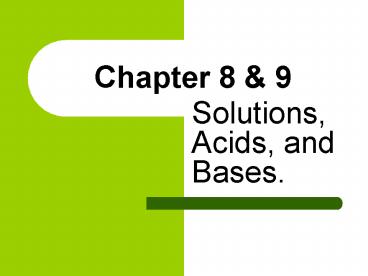Solutions, Acids, and Bases' - PowerPoint PPT Presentation
1 / 67
Title:
Solutions, Acids, and Bases'
Description:
A mixture that looks uniform when stirred or shaken that separates into ... Lemons, limes, vinegar, and dill pickles. Indicator: ... – PowerPoint PPT presentation
Number of Views:108
Avg rating:3.0/5.0
Title: Solutions, Acids, and Bases'
1
Chapter 8 9
- Solutions, Acids, and Bases.
2
- Solutions and other Mixtures.
3
Suspension
- A mixture that looks uniform when stirred or
shaken that separates into different layers when
it is no longer agitated.
4
(No Transcript)
5
Colloid
- A mixture of very tiny particles of pure
substances that are dispersed in another
substance but do not settle out of the substance.
6
Examples of colloids
- Gelatin.
- Egg white.
- Paint.
- Blood.
- Fog.
7
(No Transcript)
8
Emulsion
- Any mixture of immiscible liquids in which the
liquids are spread throughout one another.
Examples mayonnaise, cream
9
(No Transcript)
10
Heterogeneous liquid-liquid mixtures
- A mixture of immiscible liquids.
- Salad dressing (Oil and vinegar).
11
Q. Can fish drown?
- Yes, fish will drown if there not enough oxygen
in the water.
12
(No Transcript)
13
Solution
- A homogeneous mixture of two or more substances
uniformly spread throughout a single phase. Ex
salt in water.
14
(No Transcript)
15
Solutions can also be solids.
- Sapphires
- Rubies.
16
(No Transcript)
17
(No Transcript)
18
Alloys are solid solutions of metals
- Brass is a solid solution of zinc and copper.
19
(No Transcript)
20
Gaseous solutions
- Air
- 78nitroge
- 21oxygen
- 1 other gases
21
(No Transcript)
22
Solute
- The substance that dissolves in a solution.
- Salt is the solute.
23
Solvent
- The substance that dissolves the solute to make a
solution. - Water is the solvent.
24
Miscible liquids mix to form solutions
- Water isopropanol make a solution of rubbing
alcohol. - Acetic acid water make vinegar.
25
Methods of separating miscible liquids
- Distillation depends on the different boiling
points of the liquids. - Chromatography see p.191.
26
- Dissolving and Solubility.
27
Factors affecting dissolving
- Solutes with larger surface area dissolve faster.
- Stirring or shaking increases dissolving.
28
- Hot solvents dissolve the solute faster.
- Some substances are insoluble in water.
29
Water is the universal solvent.
- Water is a polar molecule
30
Likes Dissolve Likes.
- Polar molecules dissolve only polar molecules.
Oil dissolves in gasoline but not in water. Oil
gasoline are nonpolar.
31
Concentration
- The quantity of solute dissolved in a given
quantity of solution.
32
Unsaturated solution
- A solution that is able to dissolve more solute.
33
Saturated solution
- A solution that cannot dissolve any more solute
at the given conditions.
34
(No Transcript)
35
Supersaturated solution
- A solution holding more dissolved solute than is
specified by its solubility at a given
temperature.
36
(No Transcript)
37
Solubility
- The greatest quantity of a solute that will
dissolve in a given quantity of solvent to
produce a saturated solution.
38
Molarity
- A concentration unit of a solution that expresses
moles of solute dissolved per liter of solution.
39
- Molarity Moles of solute/ Liters of solution.
- M mol/L
40
Discussion
- Hexane (C6H14) is nonpolar, will it dissolve in
water? - Why is chewable medication faster-reacting in
your body?
41
- Acids, Bases, and pH.
42
Acid
- A substance that donates hydrogen ions, H, to
form hydronium ions, H3O, when dissolved in
water.
43
Examples of acids include
- Lemons, limes, vinegar, and dill pickles.
44
(No Transcript)
45
Indicator
- A compound that can reversibly change color in a
solution, depending on the concentration of H3O
ions. Ex litmus paper.
46
(No Transcript)
47
Strong acids
- Donate the hydronium ions readily.
- Ex hydrochloric acid HCl
48
(No Transcript)
49
Weak acids
- Do not readily donate the hydronium ions.
- Ex acetic acid citric acid.
50
Acids conduct electricity.
- Strong acids conduct electricity better than weak
acids, because they ionize completely.
51
(No Transcript)
52
Base
- A substance that either contains hydroxide ions,
OH-, or reacts with water to form hydroxide ions. - Foods that are basic taste bitter. Bases are
also slippery.
53
Examples of bases
- Ammonia.
- Sodium hydroxide NaOH
- Antacids.
54
(No Transcript)
55
pH
- A measure of the hydronium ion concentration in a
solution. - How acidic?
56
pH scale
- Scale that ranges from 0-14.
- pH less than 7 is acidic.
- pH more than 7 is basic.
- pH 7 is neutral.
57
- If H gt OH- acidic solution.
- If OH gt H basic solution.
- If H OH- neutral solution.
58
Neutralization reaction
- A reaction in which hydronium ions from an acid
and hydroxide ions from a base react to produce
water molecules.
59
(No Transcript)
60
- Acid Base ? salt water
- HCl NaOH? NaCl H2O
61
Acidic or basic?
- A soapy solution, pH9
- A sour liquid, pH5
- Pure water.
- A solution with more hydrogen ions than hydroxide
ions.
62
Sec 6.4
- Acids and Bases in the Home.
63
Cleaning products
- Soap is a basic cleaner that can dissolve in both
water and oil. When you wash your face with
soap, it removes the oil droplets.
64
- Detergents are also basic that can remove dirt
and oil.
65
- Ammonia, bleach, and disinfectants are basic.
- Antacids are weak bases that neutralize excess
stomach acid.
66
(No Transcript)
67
Discussion
- List three acidic household substances and three
basic substances.































